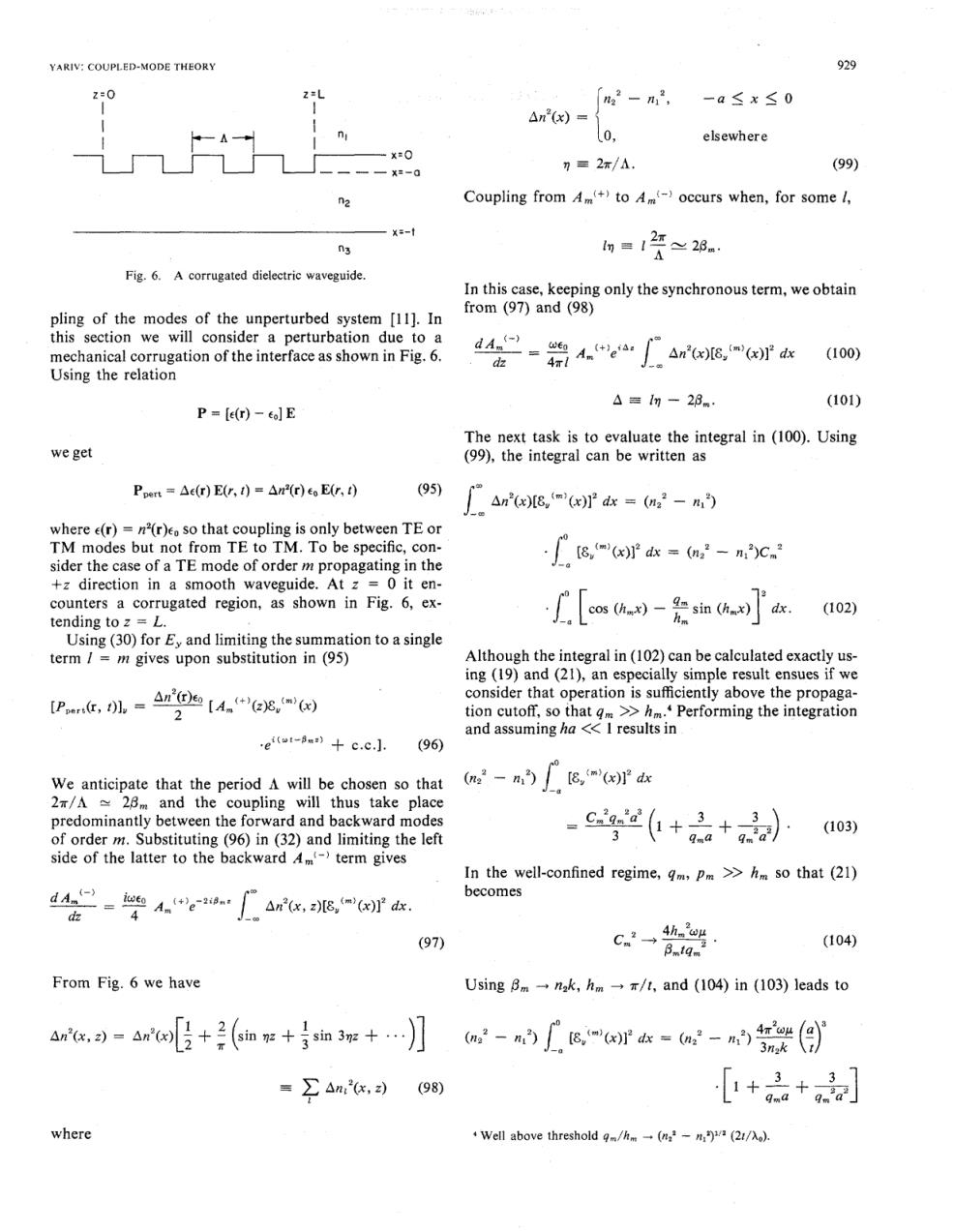正在加载图片...

YARIV:COUPLED-MODE THEORY 929 =0 n22-n12, -a≤x≤0 △n2(x)= 0, elsewhere “X=0 ”三2x/A. (99) n2 Coupling from Am+)to Am occurs when,for some l, n3 M=12年≈28 Fig.6.A corrugated dielectric waveguide. In this case,keeping only the synchronous term,we obtain from (97)and(98) pling of the modes of the unperturbed system [11].In this section we will consider a perturbation due to a dA. mechanical corrugation of the interface as shown in Fig.6. 4金-74.n,rk (100) Using the relation △=1m-23m (101) P=[e(r)-6o]E The next task is to evaluate the integral in (100).Using we get (99),the integral can be written as Ppert Ac(r)E(r,t)=An2(r)E(r,t) (95) aeears=m-a where e(r)=n2(r)eo so that coupling is only between TE or TM modes but not from TE to TM.To be specific,con- 8()dx=(n2n'C sider the case of a TE mode of order m propagating in the +z direction in a smooth waveguide.At z =0 it en- counters a corrugated region,as shown in Fig.6,ex- [cosh-是sh]了 .(102) tending to z L. Using(30)for Ey and limiting the summation to a single term /m gives upon substitution in (95) Although the integral in(102)can be calculated exactly us- ing (19)and (21),an especially simple result ensues if we Prk,l,=ne【A“ee,a6 consider that operation is sufficiently above the propaga- 2 tion cutoff,so that qm>>hm.Performing the integration and assuming ha <I results in ewt-Bn)十c.c.l. (96) We anticipate that the period A will be chosen so that (n22-n [8 (x)dx 2/A 28m and the coupling will thus take place predominantly between the forward and backward modes (103) of order m.Substituting(96)in (32)and limiting the left side of the latter to the backward Am-term gives In the well-confined regime,qm,pm>>hm so that (21) dAs=lute A becomes △n2(x,z[8,m(x)]2dx 4 4h2u4 (97) C2→ Bmtqm (104) From Fig.6 we have Using Bm-nak,hm/t,and (104)in (103)leads to △n,=ano0+26m肥+n3g+…门 --r-( =∑an(,z动 (98) [+品+] where Well above threshold gm/hm(n2-n,)(21/o).YARIV: COUPLED-MODE THEORY 929 \nZ2 - nI2, --a 5 x 5 o An2(x) = 10, elsewhere 7 = 2a/A. (99) z=o I z=L I "2 x=-t "3 Fig. 6. A corrugated dielectric waveguide. pling of the modes of the unperturbed system [ll]. In this section we will consider a perturbation due to a mechanical corrugation of the interface as shown i Fig. 6. Using the relation P = [c(r) - e,] E we get P,,,, = A4r) E(r, 2) = Anz(r) eo E(r, t) (95) where e(r) = n2(r)e0 so that coupling is only between TE or TM modes but not from TE to TM. To be specific, consider the case of a TE mode of order m propagating in the +z direction in a smooth waveguide. At z = 0 it encounters a corrugated region, as shown in Fig. 6, extending to z = L. Using (30) for Ey and limiting the summation to a single term 1 = rn gives upon substitution in (95) .e + c.c.]. (96) i(wt-Om2) We anticipate that the period A will be chosen so that 2n/h = 2@, and the coupling will thus take place predominantly between the forward and backward modes of order rn. Substituting (96) in (32) and limiting the left side of the latter to the backward A,(-) term gives (97) From Fig. 6 we have Coupling from A,(+) to A,(-) occurs when, for some 1, In this case, keeping only the synchronous term, we obtain from (97) and (98) The next task is to evaluate the integral in (100). Using (99), the integral can be written as . la [cos @,x) - hm sin (h,x) 1' dx. (1 02) Although the integral in (102) can be calculated exactly using (19) and (21), an especially simple result ensues if we consider that operation is sufficiently above the propagation cutoff, so that q, >> h,.4 Performing the integration and assuming ha << 1 results in In the well-confined regime, qm, pm >> h, so that (21) becomes Using P, 3 n2k, h, + r/t, and (104) in (103) leads to An12(x, z) (98) 1 where 'Well above threshold q,/h, + (nzz - n,z)l/z (2t/X,)